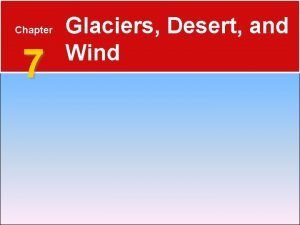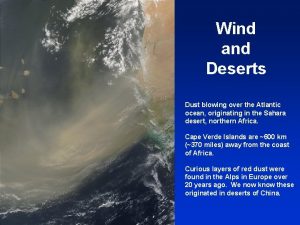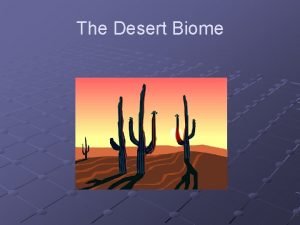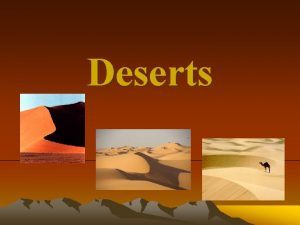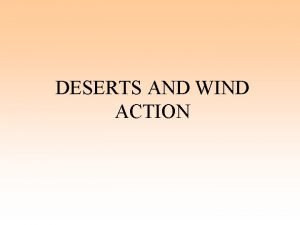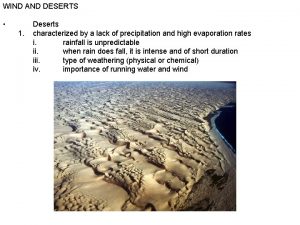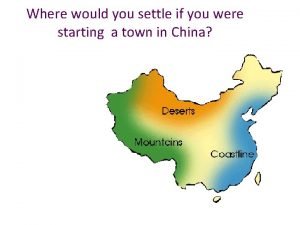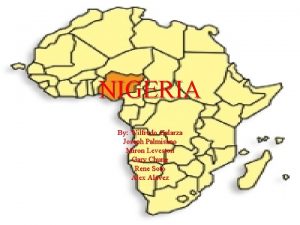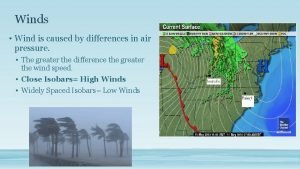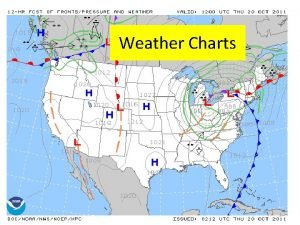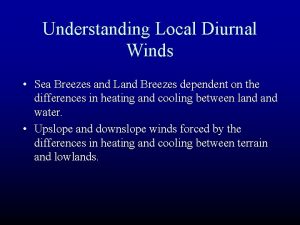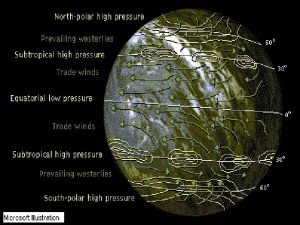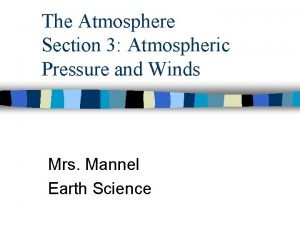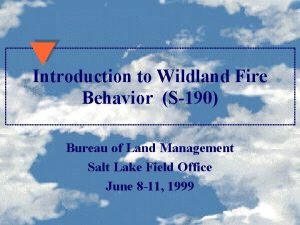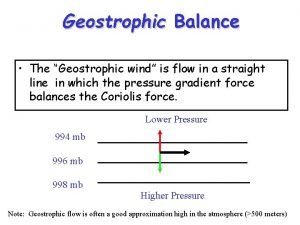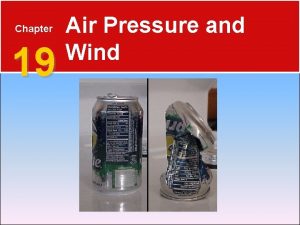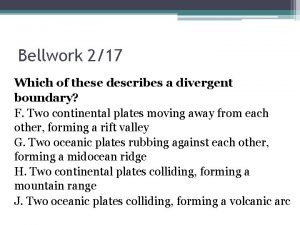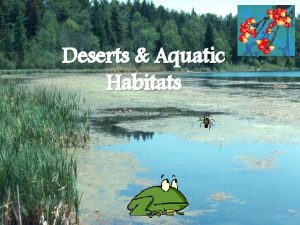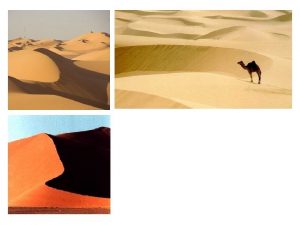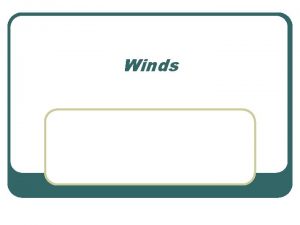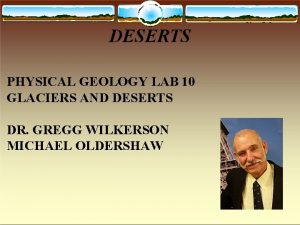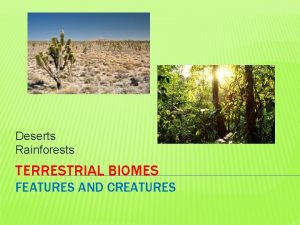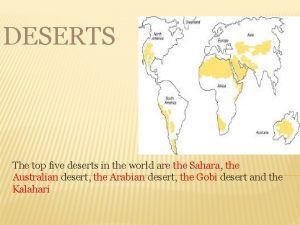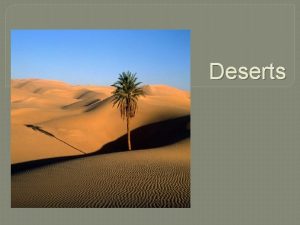Deserts and Winds Chapter 19 A typical desert























































- Slides: 55

Deserts and Winds Chapter 19

A typical desert landscape, Sonoran Desert east of Phoenix, Arizona

Distribution and causes of dry lands Dry regions cover 30 percent of Earth’s land surface Two climatic types are commonly recognized • Desert or arid • Steppe or semiarid

Arid and Semiarid Climates Cover @ 30% of Earth’s Land Surface. No Other Climate Group Covers So Much Area

Distribution and causes of dry lands Dry regions are characterized by a combination of two important factors Ø Minimal rainfall (typically 5 -10 inches annually) Ø High rates of evaporation (evaporation > precipitation)

Deserts are Defined by a Combination of Average Annual Temperature, Average Annual Rainfall, & How the Rainfall is Distributed

Distribution and causes of dry lands Because evaporation is greatly reduced in a cold climate, areas near the earth’s poles can experience relatively little rainfall and still not exhibit desert conditions. Climatologists consider the average annual temperature, the total annual precipitation & when the rain falls in determining desert conditions

Distribution and causes of dry lands Dry lands are concentrated in two regions • Subtropics – Low-latitude deserts – In the vicinities of the Tropics of Cancer and Capricorn – Areas of high pressure and sinking air that is compressed and warmed, resulting in little rainfall http: //study. com/academy/lesson/subtropical-desert-climate-andbiome. html

Earth’s Wind Circulation Patterns Produce Sinking Air & Little Rain Near the Subtropical High Pressure Belts

Distribution and causes of dry lands Dry lands are concentrated in two regions • Middle-latitudes – Located in the deep interiors of continents – High mountains in the path of the prevailing winds produce a rainshadow desert

Rainshadow deserts form in earth’s mid-latitude regions when high mountains cause air to rise and rain on their windward sides, then sink without raining on the leeward sides

Note the Distribution of Desert & Steppe Climates. They are Concentrated along the Subtropical Highs and in the Rainshadows of High Mountain Ranges. There are NO Deserts in the Polar Regions

Distribution and causes of dry lands Human activity can hasten the “desertification” of steppe regions, usually as the result of excess water comsumption for grazing or irrigation Areas at particular risk today include the southern Sahara steppe and the Aral Sea

The Aral Sea was replenished primarily by water from the Amu & Syr Rivers. Since 1960, most of their waters have been diverted for irrigation

The Aral Sea is Shrinking Rapidly. It’s Fishing Economy is Gone & Entire Towns Are Disappearing. Other Areas Are Blooming, But This Region is Being Destroyed.

Geologic processes in arid climates Weathering • Not as effective as in humid regions • Mechanical weathering produces unaltered rock and mineral fragments • Some chemical weathering in deserts does produce – Clay – Thin soils – Oxidized minerals

Geologic processes in arid climates Role of water in arid climates • Practically all streambeds are dry most of the time • Desert streams are classified as ephemeral – Carry water only during periods of rainfall – Different names are used for desert streams in various region – Wash and arroyo (western United States) – Wadi (Arabia and North Africa) • Despite its scarcity, water is still the major erosive agent in deserts

Desert Streams are Ephemeral – They Rarely Contain Water – But Erosion is Dramatic When “The Rains” Come

Geologic processes in arid climates Role of water in arid climates • Desert rainfall – Rain often occurs as heavy, localized showers – Because desert vegetative cover is sparse, runoff is largely unhindered and flash floods are common – Poorly integrated drainage systems and streams lack an extensive system of tributaries – Most of the erosion work in a desert is done by running water

Rains in the Desert Can Be Spectacular and Quite Heavy, But They Cover Small Geographic Areas Tucson, Arizona, a desert Van Horn, Texas, a steppe

Basin and Range: Evolution of a desert landscape Characterized by interior drainage Landscape evolution in the Basin and Range region • Uplift of mountains – block faulting • Interior drainage into basins produces – Alluvial fans – Bajadas – Playas and Playa lakes

Typical “Block Faulting” (Normal Faulting) Creates Basin and Range Topography in Parts of the Western United States

Most Block Faulted Mountains in the Basin & Range Are Actually Horsts and Grabens. The Mountains Are Faulted on Both Sides and Moved “Up” Relative to the Intervening Valleys

Alluvial Fans Develop Along Horst Mountain Blocks in the Basin and Range Province Where Stream Gradients Change Abruptly from Steep to Flat

Coalescing Alluvial Fans Form Bajadas Along the Horst Block Mountain Fronts in Death Valley, Basin & Range Province

Playas Are Dry Lake Beds that are Common in the Graben Valleys of the Basin & Range. They Often Display Evaporative Salt Crusts Bajada Playa

When Localized Rains Fills the Playa with Water, it Becomes a Playa Lake

Basin and Range: Evolution of a desert landscape Landscape evolution in the Basin and Range region • Ongoing erosion of the mountain mass – Produces sediment that fills the basin – Diminishes local relief – Produce isolated erosional remnants called inselbergs

Without Continued Uplift, the Horst Block Mountains are Gradually Eroded. The Resulting Sediment Fills the Graben Valleys, Leaving Only Isolated Inselbergs as Erosional Remnants

An Inselberg (Erosional Mountain Remnant) in the Basin & Range of Southern California

Mount Uluru (Formerly Ayers Rock) is an Inselberg in the Center of the Australian Outback

Wind in the desert Transportation of sediment by wind • Differs from that of running water in two ways – Wind is less capable of picking up and transporting coarse materials – Wind is not confined to channels and can spread sediment over large areas

Wind in the desert Transportation of sediment by wind • Mechanisms of transport – Bedload – Saltation – skipping and bouncing along the surface – About 20 to 25 percent of the sand transported in a sandstorm is moved this way – Suspended load – Silt and clay can be carried by wind for long distances

A Cloud of Saltating Sand Grains (Bed Load) Moves up the Gentle Slope of a Dune During a Time of High Desert Wind Velocity

Silt and Clay (Suspended Load) Transported by Wind During the “Dust Bowl” Days of the 1930’s

Dust from the Sahara Desert is transported by wind toward the Canary Islands. The Sahara is the world’s largest dust source today.

Wind in the desert Wind erosion • Wind is a relatively insignificant erosional agent with most erosion in a desert performed by intermittent running water • Mechanisms of wind erosion – Deflation – Lifting of loose material – Deflation produces blowouts (shallow depressions) and desert pavement (a surface of coarse pebbles and cobbles)

Formation of a Blowout (A) Area Prior to Deflation (B) Shallow Depression After Deflation Has Removed Fine -Grained, Loose Material

Soil Mound Below The Bush Shows the Land Surface Prior to Blowout Formation

Formation of Desert Pavement! If Undisturbed, the Concentrated Layer of Coarse Pebbles Will Prevent Further Erosion, But The Layer is Thin & Easily Disrupted

Undistrubed Desert Pavement

Wind in the desert Wind erosion • Mechanisms of wind erosion – Abrasion – Produces ventifacts (stones with flat faces) and yardangs (wind sculpted ridges) – Limited in vertical extent

Ventifacts – Rocks That Are Polished and Shaped by Sandblasting

Wind in the desert Wind deposits • Significant depositional landforms are created by wind in some regions • Two types of wind deposits – Dunes – Mounds or ridges of sand – Often asymmetrically shaped – Windward slope is gently inclined and the leeward slope is called the slip face

Dunes Have an Asymmetrical Shape, with a Gently Sloping Windward Side and a Steeply Dipping Leeward Side (the Slip Face)

The Slip Face is Aptly Named. Because Grains are at or near the Angle of Repose, they readily Slide Down the Slip Face

Dune Deposits Are Characterized by their Dramatic Cross-Bedding, Which is Produced When Wind Directions Shift

Wind in the desert Wind deposits • Two types of wind deposits – Dunes – Slow migration of dunes occurs in the direction of wind movement – Several types of sand dunes are formed, including barchan, transverse, longitudinal, parabolic and star dunes

Dunes Display Various Shapes & Sizes, Controlled by a Combination of Wind Direction & Velocity, Abundance of Sand & Amount of Vegetation

Barchan Dunes – Crescent-Shaped with Tips Pointing Downwind. Form When Sand Supply is Limited & Ground is Flat, Hard & Largely Free of Vegetation Wind Directio n

Barchanoid Dunes – Transverse Dunes with Scallops. White Sands National Monument Transverse Dunes – Long Ridges Separated by Troughs. Form When Sand Supply is Abundant, Winds Are Steady & Vegetation is Sparse Wind Direction

Longitudinal Dunes – Long Sand Ridges Somewhat Parallel to the Prevailing Wind. Form When Sand Supply is Moderate & Wind Direction Variable, But Out of the Same Quadrant Parabolic Dunes – Crescent Shaped with Tips Pointing Upwind. Form along Coastlines Where There is a Strong Onshore Wind, Abundant Sand & Vegetation to Stabilize the Dune

Star Dunes – Dunes that Create Isolated Hills of Sand that Display Complex Shapes. Form When Wind Directions Are Variable. Largely Confined to the Sahara & Arabian Deserts

Wind in the desert Wind deposits • Two types of wind deposits – Loess – Blankets of windblown silt – Two primary silt sources are deserts and glacial outwash deposits – Extensive deposits occur in China and the central United States

Loess Bluff @ 9 feet high along the Mississippi River. The Source of the Silt is Glacial Outwash
 Local and global winds
Local and global winds Easterlies and westerlies
Easterlies and westerlies Global wind belts
Global wind belts Narrow belts of high speed winds
Narrow belts of high speed winds Local winds differ from global winds because they
Local winds differ from global winds because they Chapter 7 glaciers deserts and wind
Chapter 7 glaciers deserts and wind The soldier decided to desert his dessert in the desert
The soldier decided to desert his dessert in the desert What causes wind to blow
What causes wind to blow How were deserts formed
How were deserts formed How are deserts formed
How are deserts formed Food deserts in minnesota
Food deserts in minnesota Desert climate facts
Desert climate facts Formed by wind action
Formed by wind action What causes deserts
What causes deserts Characteristics of deserts
Characteristics of deserts Ancient china on a map
Ancient china on a map Deserts cover about
Deserts cover about Deserts
Deserts Rain shadow deserts
Rain shadow deserts China size compared to us
China size compared to us What are deserts
What are deserts Nigerian deserts
Nigerian deserts Veering and backing winds
Veering and backing winds Veering and backing winds
Veering and backing winds Narrow belts of high speed winds
Narrow belts of high speed winds What is the difference between global and local winds?
What is the difference between global and local winds? Epistrophe
Epistrophe The tempest is raging
The tempest is raging Types of winds
Types of winds Codes and conventions of a short film
Codes and conventions of a short film Atypical pneumonia
Atypical pneumonia Woodbridge cruising club
Woodbridge cruising club Winds are caused by differences in
Winds are caused by differences in How are winds named
How are winds named What causes winds
What causes winds Classification of wecs
Classification of wecs Low level prognostic chart
Low level prognostic chart High pressure winds
High pressure winds Diurnal winds
Diurnal winds Ray's heating & air conditioning
Ray's heating & air conditioning Types of winds
Types of winds Satellite derived winds
Satellite derived winds Wind veer
Wind veer High pressure winds
High pressure winds Satellite derived winds
Satellite derived winds Three visual indicators of lightning and thunderstorms
Three visual indicators of lightning and thunderstorms Doldrums winds
Doldrums winds Global winds are caused by
Global winds are caused by High pressure winds
High pressure winds Geostropic winds
Geostropic winds Merciless iced winds that knive us
Merciless iced winds that knive us A sea breeze usually originates during the ____.
A sea breeze usually originates during the ____. Lesson 3 the war winds down
Lesson 3 the war winds down Which statement describes global winds?
Which statement describes global winds? Green band
Green band Oaks grow strong in contrary winds
Oaks grow strong in contrary winds





